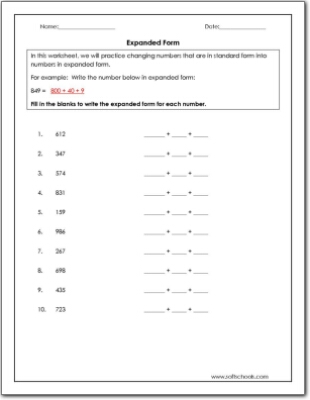

I want you to talk to your partner and see if you can figure out what expanded notation is and how it’s different from expanded form.

Alright, now I’m going to write 234 in expanded notation. Teacher: Right! And expanded form shows us the value of each digit, right? (Points to the expanded form for 234). Now, mathematicians, I’m going to show you a special way that mathematicians describe numbers. (writes it on the board) Now, can you write expressions for the tens and ones? (Gives students a minute or two) Great! I see 3 x 10 and 4 x 1. Teacher: Okay, I see lots of you wrote 2 x 100. **Note: some kiddos might write 2 x 100 = 200. Work with your partner to write that as a multiplication expression.

Hmmm, so I wonder if we could write the value of these materials using multiplication? Jayden said that this (holding up the two flats) is 2 times 100. Teacher: (to the class) Give me a thumbs up if you agree with Jayden and understand what he said. Haley: Jayden said it’s 2 times 100 because there are two flats and each is worth 100. Teacher: (to the class) Hmmm, what do you guys think about that? Who can restate what Jayden just said? It’s the same with the tens and the ones. Jayden: (holds up the two flats) Well, there’s two of these and each is 100, so that’s 2 times 100. Teacher: Can you explain that to the other mathematicians? Jayden: We see 2 times 100 and 3 times 10 and 4 times 1. (gives students time to talk and then, based on a conversation she overheard, she calls on Jayden) Does anybody see multiplication represented by your blocks? Remember, multiplication is equal groups. Paula: 200 + 30 + 4 (teacher writes it on the board) Teacher: Excellent! How could we write that in expanded form? (2nd-grade skill) Teacher: Who can describe what you built? **Note: when working with base-10 blocks, I like to use relatively small digits, so it doesn’t take them forever to build the numbers Teacher: Work with your partner to build the number 234 with your base-10 blocks To me, it would look and sound something like this: So how can we introduce the concept of expanded notation? As with any other math skill, it’s best if the students can discover it on their own. Because expanded notation is a relatively new concept for both 4th and 5th grade, and it is incredibly abstract, hands-on materials are still essential for understanding even in the upper grades. But the manipulatives don’t stop in 3rd grade. Another great manipulative that will allow you to extend the concept up to larger numbers, while still using hands-on materials, is place value disks. While the standard in 3rd grade is for numbers up to 100,000, you’ll want to introduce and practice the skill with 3- or 4-digit numbers, so you can use manipulatives, such as base-10 blocks to provide support for the learning. Teaching expanded notation is still very doable, as long as the learning is concrete and there is an awareness that you are teaching multiplication as well as place value. One thing that is tricky about teaching expanded notation in 3rd grade is that students are only beginning to develop an understanding of multiplication. Remember that our new standards, whether the TEKS or CCSS, are all about understanding the relationships in numbers, and expanded notation emphasizes the place value understandings that we want our students to develop. I think it’s easy to see that expanded notation is definitely a mathematical step up from expanded form. So what is the difference between standard form and standard notation? Take a look at these examples:Įxpanded notation: 234 = (2 x 100) + (3 x 10) + (4 x 1)

There is no additional cost to you, and I only link to books and products that I personally use and recommend. This post contains affiliate links, which simply means that when you use my link and purchase a product, I receive a small commission. When was the last time you wrote a number in the millions or billions in word form? Also gone is writing numbers in word form past 2nd grade. I’m talking about the change from expanded form to expanded notation in grades 3-5. Among all the tsunami-force changes that took place as we moved to our new elementary TEKS (Texas Essential Knowledge and Skills) in 2012, one rather subtle shift might have been overlooked.


 0 kommentar(er)
0 kommentar(er)
